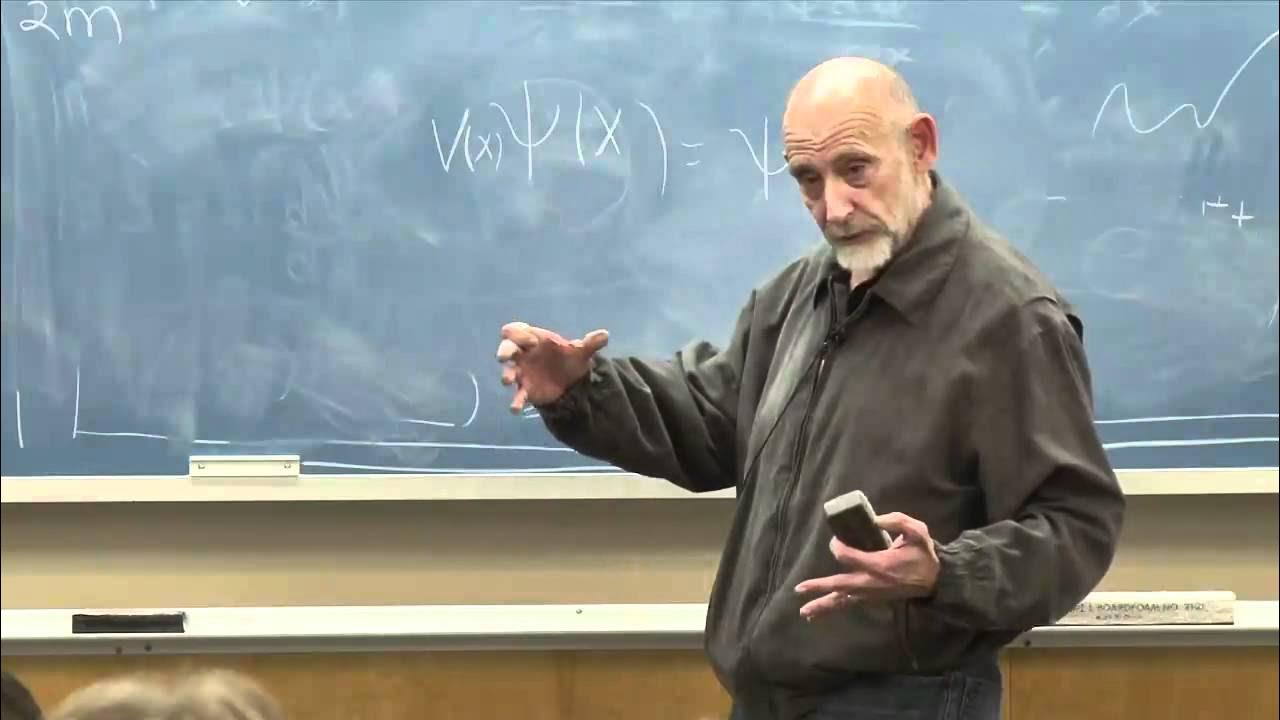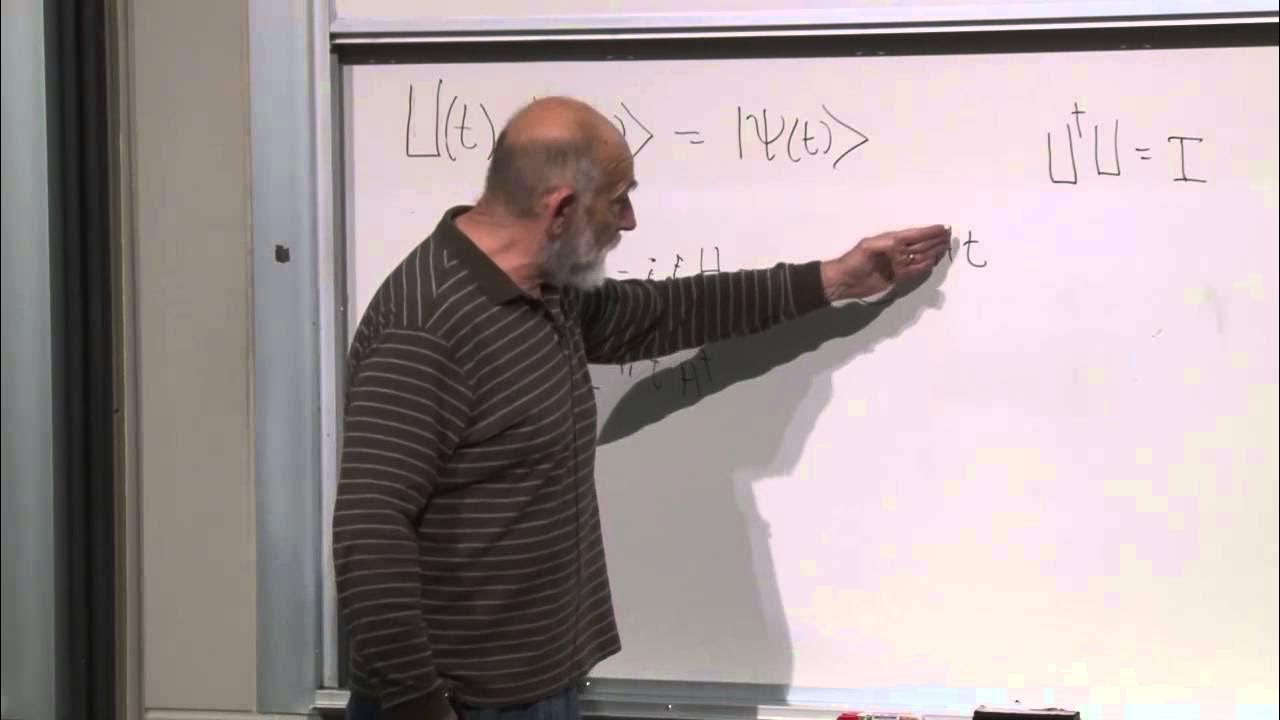Ch 10: What's the commutator and the uncertainty principle? | Maths of Quantum Mechanics
TLDRThis video delves into the concept of the commutator, a pivotal mathematical tool for understanding observables in quantum mechanics. It explains how the commutator's non-zero value indicates that certain observables, like position and momentum, cannot have simultaneous eigenbases, leading to the Heisenberg uncertainty principle. The video also touches on the implications of commuting and non-commuting operators on the measurability of physical properties and introduces the generalized uncertainty principle, highlighting the profound impact of linear algebra on our comprehension of quantum physics.
Takeaways
- 📌 The commutator is a crucial mathematical tool for studying observables in quantum mechanics.
- 🔄 Two operators A and B are said to commute if AB = BA, meaning the order of the operators can be switched without affecting the result.
- 🎯 The definition of the commutator involves a bracket and is given by the difference [AB] = AB - BA.
- ✅ If two operators commute, their commutator is zero, and vice versa.
- 🤹 Commuting observables allow for the simplification of expressions and the use of eigenvector properties.
- 🌐 In quantum physics, commuting observables have orthonormal eigenbases and share a simultaneous eigenbasis.
- 🔑 Nondegenerate eigenvectors of one commuting observable must also be eigenvectors of the other.
- 🔍 For degenerate eigenvalues, the eigenvectors of one observable either lie within the eigenspace of the other or are orthogonal to it.
- 🌟 The inability to have a simultaneous eigenbasis for non-commuting observables leads to the uncertainty principle.
- 📈 The position and momentum operators have a non-zero commutator, which means they do not share an eigenbasis and cannot be simultaneously measured.
- 🚫 The Heisenberg uncertainty principle is a direct consequence of the commutator, stating that certain pairs of physical properties, like position and momentum, cannot be precisely known at the same time.
Q & A
What is the definition of two operators A and B commuting?
-Two operators A and B are said to commute if the action of operator AB is equal to the action of operator BA. In other words, you can flip the order of the two operators without any issues.
What is the significance of the commutator in quantum mechanics?
-The commutator is a crucial mathematical tool in quantum mechanics because it tells us whether observables have a simultaneous eigenbasis, and therefore, whether they can be simultaneously measured. It is directly related to the uncertainty principle, as non-commuting operators cannot have a simultaneous eigenbasis, leading to inherent uncertainties in their measurements.
How does the commutator of two operators A and B help in simplifying expressions?
-If two operators A and B commute, their commutator is zero. This property allows us to rearrange the order of operators in expressions without changing the result. If the commutator is non-zero, it represents a third operator C, and we can still rearrange the product of A and B by adding or subtracting this commutator C.
What happens when two physical observables A and B commute and have orthonormal eigenbases?
-If two observables A and B commute and have orthonormal eigenbases, they share a simultaneous eigenbasis. This means that any eigenvector of one observable is also an eigenvector of the other, allowing for the simultaneous measurement of both observables with certainty.
What are the implications of non-commuting observables in terms of measurement?
-Non-commuting observables cannot have a simultaneous eigenbasis, which means that there are no states that are eigenstates of both observables at the same time. This leads to the uncertainty principle, where the more precisely one observable is measured, the less precisely the other can be known.
What is the Heisenberg uncertainty principle derived from?
-The Heisenberg uncertainty principle is derived from the generalized uncertainty principle, which focuses on the commutator of operators. It states that the product of the standard deviations of position and momentum must always be greater than zero, meaning that both quantities cannot be precisely known simultaneously.
What is the role of the commutator in the context of the position and momentum operators?
-The commutator of the position and momentum operators is non-zero, indicating that these operators do not commute and do not share an eigenbasis. This is the fundamental reason why one cannot simultaneously know the exact position and momentum of a particle in quantum mechanics.
How does the concept of eigenspaces and eigenvectors relate to commuting observables?
-For commuting observables, the eigenvectors of one observable must lie either inside the eigenspace of the other or be orthogonal to it. This means that the eigenvectors of one observable can be used as a basis for the other observable, leading to a shared eigenbasis and the ability to make simultaneous measurements.
What is a stronger form of the uncertainty principle mentioned in the script?
-The Maccone–Pati uncertainty relation is mentioned as a stronger form of the uncertainty principle. It involves the sum of variances and includes more complex expressions involving the commutator and other operators.
How does the commutator relate to the eigenvalues and eigenvectors in the case of degenerate eigenvalues?
-In the case of degenerate eigenvalues, the commutator helps to show that the eigenvectors of one observable must either lie within the eigenspace of the other or be orthogonal to it. This leads to the conclusion that eigenvectors can be found that are eigenvectors of both observables, even in the presence of degeneracy.
What is the significance of the commutator in the overall framework of quantum mechanics?
-The commutator is significant in quantum mechanics because it underpins the fundamental principles of the theory, such as the uncertainty principle. It dictates the possibility of simultaneous measurements of observables and is central to understanding the behavior of quantum states under measurement and observation.
Outlines
🔍 Introduction to Commutators and Quantum Uncertainty
This paragraph introduces the concept of commutators, a fundamental mathematical tool in quantum mechanics. It explains that if two operators A and B commute, their action can be interchanged without affecting the result. The importance of commutators is highlighted by their connection to uncertainty relations in quantum mechanics. The video aims to build intuition around why uncertainty relations, such as the Heisenberg uncertainty principle, exist due to the non-commutative nature of certain observables.
📐 Exploring Commuting Observables and Eigenbases
The second paragraph delves into the properties of commuting observables and their shared eigenbases. It discusses the implications of nondegenerate and degenerate eigenvalues, explaining how eigenvectors of one observable can also be eigenvectors of another if they commute. The paragraph uses the example of a twofold degeneracy in R3 to illustrate how eigenvectors within an eigenspace remain within it when acted upon by a commuting observable. It also touches on the concept of eigenvectors being orthogonal to the eigenspace when considered in the context of degenerate eigenvalues.
🌀 The Connection Between Commutators and Eigenvectors
This paragraph establishes the connection between the commutator of two operators and their eigenvectors. It explains that if two operators A and B commute, they share a simultaneous eigenbasis, meaning there exists a set of vectors that are eigenvectors for both operators. This has significant implications in physics, as it allows for the simultaneous measurement of observables like momentum and energy. The paragraph also discusses the implications of non-commuting operators, which cannot have a simultaneous eigenbasis, leading to the inherent uncertainty in measuring certain pairs of observables, such as position and momentum.
🌟 The Significance of the Commutator in Quantum Mechanics
The final paragraph emphasizes the profound impact of the commutator on our understanding of quantum mechanics. It connects the mathematical concept of non-commutativity to the physical reality of uncertainty principles, such as the Heisenberg uncertainty principle. The paragraph also mentions the generalized uncertainty principle and the Maccone–Pati uncertainty relation, both of which involve the commutator and further illustrate its importance in quantum theory. The video concludes by highlighting the beauty of how linear algebra principles underpin the fundamental aspects of quantum mechanics, including the limits of our knowledge about the universe.
Mindmap
Keywords
💡Commutator
💡Observables
💡Eigenvectors
💡Eigenvalues
💡Uncertainty Relations
💡Eigenbasis
💡Noncommuting Operators
💡Linear Operators
💡Hermitian Operators
💡Degenerate Eigenvalues
💡Superposition
Highlights
The introduction of the commutator as a crucial mathematical tool in studying observables in quantum mechanics.
Defining operators A and B as commuting if AB equals BA, allowing the order of the operators to be switched without issue.
The motivation for the commutator stems from the desire to switch the order of operators like energy and momentum in quantum calculations.
The commutator of two operators A and B is defined as a bracketed difference, [A, B] = AB - BA.
If two operators commute, their commutator is zero, and if the commutator is zero, the operators imply that they commute.
The general non-commutativity of operators leads to different transformations when the order of the operators is switched.
The derivation of a property of commuting observables where nondegenerate eigenvectors of one must also be eigenvectors of the other.
The exploration of degenerate eigenvalues and eigenspaces, showing that eigenvectors of B must lie either inside or orthogonal to the eigenspace of A.
The conclusion that commuting observables A and B share a simultaneous eigenbasis, which is a significant result in quantum physics.
The practical implication in physics where commuting observables like momentum and energy allow for simultaneous measurement of their eigenvalues.
The contrast between commuting and non-commuting operators, where non-commuting operators cannot have a simultaneous eigenbasis.
The fundamental connection between the commutator and the Heisenberg uncertainty principle, which limits simultaneous knowledge of certain pairs of observables.
The position and momentum operators are an example of non-commuting operators, leading to the impossibility of simultaneously determining their eigenvalues with certainty.
The significance of the commutator in quantum mechanics, being responsible for the 'weirdness' and foundational principles of the theory.
The mention of the generalized uncertainty principle, which includes more than one uncertainty relation, with the commutator as a central component.
The Maccone–Pati uncertainty relation as an example of a stronger form that includes the sum of variances and highlights the importance of the commutator.
The final takeaway that the commutator's non-equality prevents the simultaneous measurement of certain observables, such as position and momentum.
A preview of the upcoming discussion on unitary operators in quantum mechanics and their role in the derivation of the Schrödinger equation.
Transcripts
Browse More Related Video
5.0 / 5 (0 votes)
Thanks for rating:





